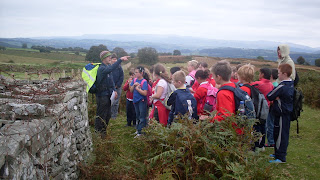
This week we have been investigating National parks. On Thursday the children used their
communication, thinking and
ICT skills to research, plan and produce a 3d fact sheet about a chosen
characteristic of
Snowdonia. The children worked in groups and looked at areas such as Seasons, Visitors to
Snowdon,
who looks after
Snowdonia etc.
They will complete this work on Monday and
feedback o the class on what they have
found out.


On Friday we actually visited a National Park. A warden called Sam took us around the park and answered all of our
questions. We had a fantastic day looking at areas such as bio-diversity (the wealth of different plants, insects and animals that live in the world), how the National park is being cared for, who comes to the National Park, how the National Park has been used in the past and how it was formed.
Bio diversity - have a look at the video below and the picture next to it. They are both taken from the same spot. The video is facing South, the photograph to the north, but direction
doesn't matter here to
answer this question. Which area do you think would have a greater
wealth of different
animals,
insects and plants. Clue: the
picture with J6 in it has been largely left to nature and woodland. The other has seen the influence of man, creating
hedgerows, walls, fertilising fields etc. (See the bottom of the blog to find out).


This tractor is cutting back the bracken so
that it can be put into bails for cattle. It is an attempt to stop the bracken from taking over all of the land.


The pool
opposite and the wall below are both examples of how man can encourage bio-diversity. Lots of different insects and species can live in the pool and the wall that otherwise wouldn't be in
the National Park.



The children had a go at reed
stripping. In the days before electricity it was a
child's job to make candles by stripping hundreds of reeds. It took us ages and although was lots of fun everyone agreed hat they wouldn't like to spend the whole day doing this job. The outer reeds would have been stripped, the reed centres dipped in animal fat and then the reeds used as candles. We had a competition to see who could get the longest reed, our three finalists are below.

The answer to
the question at the top is that the photograph on the right would have a greater wealth of
different insects, animals and plants. This is because the fields have largely been influenced by man, therefore different
species are able to live there. When an area is left to nature for a long, long time
woodland takes
over and the biodiversity is reduced. By planting
hedgerows, stone walls etc, lots of different species can
thrive, not just the species that live in woodlands.
 PESS DANCE - Mr Llewellyn
PESS DANCE - Mr Llewellyn












